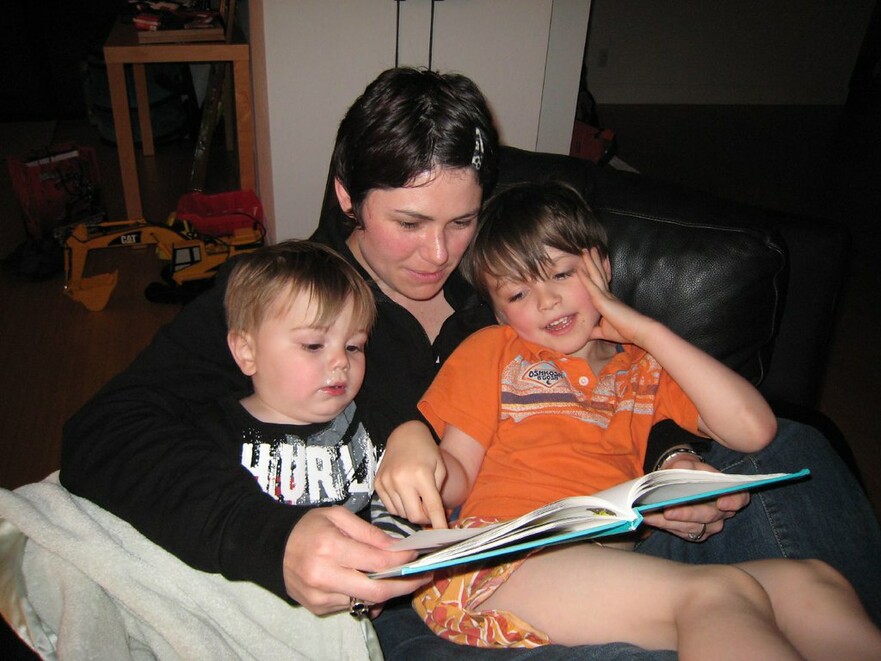Strategies for Storytelling
January 31 2021
| Holding the book – If you’re reading from a picture book, hold it in such a way where your child can see the picture and you can see the words at the same time. Try to avoid reading from the page and then holding the book up for your audience to see. This breaks up the story’s momentum and doesn’t allow the audience as much time to take in the images. | |
| Strive for interaction - Try to find ways to give the child an active role in the storytelling. For example, if a story is about animals, invite the child to make the animal’s sound every time you mention its name; if a story has a structure where certain phrases or rhymes are repeated over and over, allow the child to play along as you give them a “part” in the reading, teaching them the phrase and giving a cue on when they would say it. | |
|
Sound effects - Whenever the chance presents itself, make your very own “sound effects” by adding noises (if possible, funny ones) to the narrative; for example, if the story talks about a windy day, make an exaggerated sound of wind (or even blow a little air on your listener); if someone is walking, you can make the sound of steps to add some “drama,” and so on. If you have a musical instrument at home (even if you don’t know how to play it), you can also use it to go along with the story: a deep, grave note works wonders to make a passage scarier, and repeated high-pitch sounds marking the steps of a character as it walks can contribute to make it funny or intriguing. This can be especially fun when you’re telling stories that you know by heart—or that you’re creating on the spot—so you don’t need to keep going back and forth between book and objects/instruments/etc. |
|
| Talk, talk, talk - Talk with the child about things related to the story before you start. If a story is about a dog that gets lost, for example, talk to the child about their previous experiences with dogs and other pets; ask her if they ever got lost anywhere, how they think they would feel if they ever did, and so on. After the story, you could talk about other ways in which the story could have ended, or on ideas for producing a “sequel” to the story, etc. | |
| Rules of engagement - If a less-known word shows up in the story, it’s okay to stop (briefly!) and ask the child what that word might be; conversely, they should know that it’s okay for them to interrupt and make comments, ask questions, give ideas, and any other way in which they want to participate. | |
 |
Props will prop up your story time - Using common craft supplies, you can build simple props along with the child that could be used either to create “ambiance” (for example, a crown for the child to use as you tell a story with kings and queens) or to be engaged during story time (for example, stick puppets with characters from the story). Heck, you don’t even have to have built anything in advance beforehand! Children are the ideal listeners, because they’re able to see anything through the lenses of imagination. That means they’ll immediately agree with you when you propose that this eggplant is actually a hippo and that pile of potatoes is a pride of lions lurking in the Savannah. Everyday objects can be turned into virtually anything and kids will happily play along. |
 |
Playing with your voice - There are many ways of using your voice to add some drama to a story: at times, you will have to speak VERY LOUD or very quietly; action scenes can be told more quickly at pivotal moments, while a description of a hot, lazy day can be read almost in slow motion; different characters deserve different voices too, which will help to make them more real to your young audiences. |
Image credits:
"Debbie reading to children during Lapsit Storytime." by San José Public Library is licensed under CC BY-SA 2.0
"teaching with emotion: a halloween story" by woodleywonderworks is licensed under CC BY 2.0
"Mayor Garcetti reading to children at a Press Conference: Removal of Library Late Fines" by Mayor of Los Angeles is licensed under CC BY-NC-ND 2.0
"Maria Martinez Amigurumi: Sonajeros" by Maria Martinez Dukan is licensed under CC BY-NC-ND 2.0
By Alice Flecha (Volunteer Blogger)

